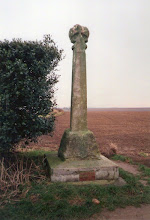My pulp adventures need more locations - I fancy a steamy jungle ruin.
The aim here is to produce a cheap, useful bit of terrain without it spending months on the craft table like all my other projects do.
I am loosely basing this (very loosely) on the
Tikal Temple II in Northern Guatemala.
Ok, I confess I was originally planning on the standard Mayan temple with the staircase on each face but I could see the job bogging down if I had to make four staircases! So a quick web search found the temple at Tikal, and Bob's your uncle!
So, the basic structure (sans stairs) has been constructed our of heavy corrugated cardboard. I'm pondering how to manage the summit shrine - partly because I've not allowed enough space - but in the mean time am wanting to get the main exterior finish sorted.
Here's how it looks at the moment:
 |
| 28mm miniature to give a sense of scale. |
I've contemplated covering it with tissue paper soaked in PVA glue to give it a uniform, rough finish, then dry brush and add a bit of vegetation. However, it would be good to get a bit of a stonework feel to the surface. The question is how?
The role of this bit of terrain is just to be a serviceable bit of pulp terrain - so it does not need a refined finish. The other criteria, is to continue with the 'no cost' strategy!
I'll post more pictures as it progresses.

























